Visibility Graph Feature Model of Vibration Signals: A Novel Bearing Fault Diagnosis Approach
Abstract
:1. Introduction
2. Methodological Framework
- Data segmentation: The signals are segmented according to the sample rate and rough shaft speed to ensure each obtained sample covers several circles of signals.
- Feature extraction: The visibility graph method is used to convert the acceleration signals into a binary matrix. From the matrix obtained, considering the feature model of the complex graph and image, we extract the feature vector within this model. We do this for all available VG feature models and produce the VG feature pool.
- Feature selection: We select the optimal number of VG features based on the diagnosis performance. Multiple classifiers can be used to estimate the performance of features.
- Results analysis: The advantage of the VG feature model is validated by comparing the performance of the VG feature model, the statistical feature model and the wavelet package feature model.
3. Visibility Graph Construction
4. VG Features’ Extraction and Selection
4.1. Candidate VG Features
4.1.1. Global VG Features
- (1)
- VG density:
- (2)
- VG complexity:
- (3)
- VG degree:
4.1.2. Local VG Features
4.2. Diagnosis Performance-Based VG Feature Selection
5. Experiments
5.1. Data and Experiments’ Description
5.2. VGAM Construction
5.3. Results and Discussion
6. Conclusions and Extension
Author Contributions
Funding
Conflicts of Interest
References
- Cheng, Y.; Zhou, B.; Lu, C.; Yang, C. Fault Diagnosis for Rolling Bearings under Variable Conditions Based on Visual Cognition. Materials 2017, 10, 582. [Google Scholar] [CrossRef] [PubMed]
- López de Lacalle, L.N.; Rodriguez, A.; Lamikiz, A.; Celaya, A.; Alberdi, R. Five-axis machining and burnishing of complex parts for the improvement of surface roughness. Mater. Manuf. Process. 2011, 26, 997–1003. [Google Scholar] [CrossRef]
- Fernández-Abia, A.I.; Barreiro, J.; de Lacalle, L.N.L.; Martínez-Pellitero, S. Behavior of austenitic stainless steels at high speed turning using specific force coefficients. Int. J. Adv. Manuf. Technol. 2012, 62, 505–515. [Google Scholar] [CrossRef]
- Boudiaf, A.; Moussaoui, A.; Dahane, A.; Atoui, I. A comparative study of various methods of bearing faults diagnosis using the case Western Reserve University data. J. Fail. Anal. Prev. 2016, 16, 271–284. [Google Scholar] [CrossRef]
- Ghafari, S.; Golnaraghi, F.; Ismail, F. Effect of localized faults on chaotic vibration of rolling element bearings. Nonlinear Dyn. 2008, 53, 287–301. [Google Scholar] [CrossRef]
- Saruhan, H.; Saridemir, S.; Qicek, A.; Uygur, I. Vibration analysis of rolling element bearings defects. J. Appl. Res. Technol. 2014, 12, 384–395. [Google Scholar] [CrossRef]
- Rai, A.; Upadhyay, S. A review on signal processing techniques utilized in the fault diagnosis of rolling element bearings. Tribol. Int. 2016, 96, 289–306. [Google Scholar] [CrossRef]
- Mahamad, A.K.; Hiyama, T. Fault classification based artificial intelligent methods of induction motor bearing. Int. J. Innov. Comput. Inf. Control 2011, 7, 5477–5494. [Google Scholar]
- Wu, S.D.; Wu, C.W.; Wu, T.Y.; Wang, C.C. Multi-scale analysis based ball bearing defect diagnostics using Mahalanobis distance and support vector machine. Entropy 2013, 15, 416–433. [Google Scholar] [CrossRef]
- Peter, W.T.; Peng, Y.; Yam, R. Wavelet analysis and envelope detection for rolling element bearing fault diagnosis-their effectiveness and flexibilities. J. Vib. Acoust. 2001, 123, 303–310. [Google Scholar]
- Eren, L.; Devaney, M.J. Bearing damage detection via wavelet packet decomposition of the stator current. IEEE Trans. Instrum. Meas. 2004, 53, 431–436. [Google Scholar] [CrossRef]
- Wang, Y.; Xu, G.; Liang, L.; Jiang, K. Detection of weak transient signals based on wavelet packet transform and manifold learning for rolling element bearing fault diagnosis. Mech. Syst. Signal Process. 2015, 54, 259–276. [Google Scholar] [CrossRef]
- Yan, R.; Gao, R.X.; Chen, X. Wavelets for fault diagnosis of rotary machines: A review with applications. Signal Process. 2014, 96, 1–15. [Google Scholar] [CrossRef]
- Amar, M.; Gondal, I.; Wilson, C. Vibration Spectrum Imaging: A Novel Bearing Fault Classification Approach. IEEE Trans. Ind. Electron. 2015, 62, 494–502. [Google Scholar] [CrossRef]
- Sugumaran, V.; Ramachandran, K. Effect of number of features on classification of roller bearing faults using SVM and PSVM. Expert Syst. Appl. 2011, 38, 4088–4096. [Google Scholar] [CrossRef]
- Guyon, I.; Elisseeff, A. An introduction to variable and feature selection. J. Mach. Learn. Res. 2003, 3, 1157–1182. [Google Scholar]
- Yu, L.; Liu, H. Efficient feature selection via analysis of relevance and redundancy. J. Mach. Learn. Res. 2004, 5, 1205–1224. [Google Scholar]
- Chandrashekar, G.; Sahin, F. A survey on feature selection methods. Comput. Electr. Eng. 2014, 40, 16–28. [Google Scholar] [CrossRef]
- Lazar, C.; Taminau, J.; Meganck, S.; Steenhoff, D.; Coletta, A.; Molter, C.; Schaetzen, V.D.; Duque, R.; Bersini, H.; Nowe, A. A Survey on Filter Techniques for Feature Selection in Gene Expression Microarray Analysis. IEEE/ACM Trans. Comput. Biol. Bioinform. 2012, 9, 1106–1119. [Google Scholar] [CrossRef] [PubMed]
- Urbikain, G.; Alvarez, A.; López de Lacalle, L.N.; Arsuaga, M.; Alonso, M.A.; Veiga, F. A reliable turning process by the early use of a deep simulation model at several manufacturing stages. Machines 2017, 5, 15. [Google Scholar] [CrossRef]
- Bustillo, A.; Urbikain, G.; Perez, J.M.; Pereira, O.M.; de Lacalle, L.N.L. Smart optimization of a friction-drilling process based on boosting ensembles. J. Manuf. Syst. 2018, 48, 108–121. [Google Scholar] [CrossRef]
- Smith, W.A.; Randall, R.B. Rolling element bearing diagnostics using the Case Western Reserve University data: A benchmark study. Mech. Syst. Signal Process. 2015, 64, 100–131. [Google Scholar] [CrossRef]
- Samanta, B.; Al-Balushi, K. Artificial neural network based fault diagnostics of rolling element bearings using time-domain features. Mech. Syst. Signal Process. 2003, 17, 317–328. [Google Scholar] [CrossRef]
- Sugumaran, V.; Muralidharan, V.; Ramachandran, K. Feature selection using decision tree and classification through proximal support vector machine for fault diagnostics of roller bearing. Mech. Syst. Signal Process. 2007, 21, 930–942. [Google Scholar] [CrossRef]
- Yang, Y.; Yu, D.; Cheng, J. A fault diagnosis approach for roller bearing based on IMF envelope spectrum and SVM. Measurement 2007, 40, 943–950. [Google Scholar] [CrossRef]
- Abbasion, S.; Rafsanjani, A.; Farshidianfar, A.; Irani, N. Rolling element bearings multi-fault classification based on the wavelet denoising and support vector machine. Mech. Syst. Signal Process. 2007, 21, 2933–2945. [Google Scholar] [CrossRef]
- Djemili, R.; Bourouba, H.; Korba, M.C.A. Application of empirical mode decomposition and artificial neural network for the classification of normal and epileptic EEG signals. Biocybern. Biomed. Eng. 2016, 36, 285–291. [Google Scholar] [CrossRef]
- Lacasa, L.; Luque, B.; Ballesteros, F.; Luque, J.; Nuno, J.C. From time series to complex networks: The visibility graph. Proc. Natl. Acad. Sci. USA 2008, 105, 4972–4975. [Google Scholar] [CrossRef] [PubMed] [Green Version]
- Ni, X.H.; Jiang, Z.Q.; Zhou, W.X. Degree distributions of the visibility graphs mapped from fractional Brownian motions and multifractal random walks. Phys. Lett. A 2009, 373, 3822–3826. [Google Scholar] [CrossRef] [Green Version]
- Turner, A.; Doxa, M.; O’Sullivan, D.; Penn, A. From isovists to visibility graphs: A methodology for the analysis of architectural space. Environ. Plan. B Plan. Des. 2001, 28, 103–121. [Google Scholar] [CrossRef]
- Luque, B.; Lacasa, L.; Ballesteros, F.; Luque, J. Horizontal visibility graphs: Exact results for random time series. Phys. Rev. E 2009, 80, 046103. [Google Scholar] [CrossRef] [PubMed]
- Zhou, T.T.; Jin, N.D.; Gao, Z.K.; Luo, Y.B. Limited penetrable visibility graph for establishing complex network from time series. Wuli Xuebao 2012, 61, 355–367. [Google Scholar]
- Gao, Z.K.; Cai, Q.; Yang, Y.X.; Dang, W.D.; Zhang, S.S. Multiscale limited penetrable horizontal visibility graph for analyzing nonlinear time series. Sci. Rep. 2016, 6, 35622. [Google Scholar] [CrossRef] [PubMed] [Green Version]
- Bezsudnov, I.; Snarskii, A. From the time series to the complex networks: The parametric natural visibility graph. Phys. A Stat. Mech. Appl. 2014, 414, 53–60. [Google Scholar] [CrossRef] [Green Version]
- Zhang, B.; Wang, J.; Fang, W. Volatility behavior of visibility graph EMD financial time series from Ising interacting system. Phys. A Stat. Mech. Appl. 2015, 432, 301–314. [Google Scholar] [CrossRef]
- Rong, L.; Shang, P. Topological entropy and geometric entropy and their application to the horizontal visibility graph for financial time series. Nonlinear Dyn. 2018, 92, 41–58. [Google Scholar] [CrossRef]
- Braga, A.; Alves, L.; Costa, L.; Ribeiro, A.; de Jesus, M.; Tateishi, A.; Ribeiro, H. Characterization of river flow fluctuations via horizontal visibility graphs. Phys. A Stat. Mech. Appl. 2016, 444, 1003–1011. [Google Scholar] [CrossRef] [Green Version]
- Ahmadlou, M.; Adeli, H.; Adeli, A. New diagnostic EEG markers of the Alzheimer disease using visibility graph. J. Neural Transm. 2010, 117, 1099–1109. [Google Scholar] [CrossRef] [PubMed]
- Gao, Z.K.; Cai, Q.; Yang, Y.X.; Dong, N.; Zhang, S.S. Visibility graph from adaptive optimal kernel time-frequency representation for classification of epileptiform EEG. Int. J. Neural Syst. 2017, 27, 1750005. [Google Scholar] [CrossRef] [PubMed]
- Zeng, M.; Ma, W.; Meng, Q.; Sun, B.; Wu, Z.; Lu, J. Noise resistance ability analysis of the visibility graph and the limited penetrable visibility graph. In Proceedings of the 2016 12th World Congress on Intelligent Control and Automation (WCICA), Guilin, China, 12–15 June 2016; pp. 2648–2653. [Google Scholar]
- Derrible, S.; Kennedy, C. The complexity and robustness of metro networks. Phys. A Stat. Mech. Appl. 2010, 389, 3678–3691. [Google Scholar] [CrossRef]
- Rubinov, M.; Sporns, O. Complex network measures of brain connectivity: Uses and interpretations. Neuroimage 2010, 52, 1059–1069. [Google Scholar] [CrossRef] [PubMed]
- Opsahl, T.; Agneessens, F.; Skvoretz, J. Node centrality in weighted networks: Generalizing degree and shortest paths. Soc. Netw. 2010, 32, 245–251. [Google Scholar] [CrossRef]
- Dorogovtsev, S.N.; Mendes, J.F.; Samukhin, A.N. Size-dependent degree distribution of a scale-free growing network. Phys. Rev. E 2001, 63, 062101. [Google Scholar] [CrossRef] [PubMed]
- Fronczak, A.; Fronczak, P.; Hołyst, J.A. Average path length in random networks. Phys. Rev. E 2004, 70, 056110. [Google Scholar] [CrossRef] [PubMed]
- Peleg, D.; Roditty, L.; Tal, E. Distributed algorithms for network diameter and girth. In Proceedings of the International Colloquium on Automata, Languages, and Programming, Warwick, UK, 9–13 July 2012; pp. 660–672. [Google Scholar]
- Soffer, S.N.; Vazquez, A. Network clustering coefficient without degree-correlation biases. Phys. Rev. E 2005, 71, 057101. [Google Scholar] [CrossRef] [PubMed]
- Moosavian, A.; Ahmadi, H.; Tabatabaeefar, A.; Khazaee, M. Comparison of two classifiers; K-nearest neighbor and artificial neural network, for fault diagnosis on a main engine journal-bearing. Shock Vib. 2013, 20, 263–272. [Google Scholar] [CrossRef]
- Lei, Y.; Zuo, M.J. Gear crack level identification based on weighted K nearest neighbor classification algorithm. Mech. Syst. Signal Process. 2009, 23, 1535–1547. [Google Scholar] [CrossRef]
- Rauber, T.W.; de Assis Boldt, F.; Varejão, F.M. Heterogeneous feature models and feature selection applied to bearing fault diagnosis. IEEE Trans. Ind. Electron. 2015, 62, 637–646. [Google Scholar] [CrossRef]
- Needham, T. A visual explanation of Jensen’s inequality. Am. Math. Mon. 1993, 100, 768–771. [Google Scholar] [CrossRef]
- Porter, R.; Canagarajah, N. Robust rotation-invariant texture classification: Wavelet, Gabor filter and GMRF based schemes. IEE Proc. Vis. Image Signal Process. 1997, 144, 180–188. [Google Scholar] [CrossRef]
- Intanagonwiwat, C.; Estrin, D.; Govindan, R.; Heidemann, J. Impact of network density on data aggregation in wireless sensor networks. In Proceedings of the 22nd International Conference on Distributed Computing Systems Workshops, Vienna, Austria, 2–5 July 2002; pp. 457–458. [Google Scholar] [Green Version]
- Strogatz, S.H. Exploring complex networks. Nature 2001, 410, 268. [Google Scholar] [CrossRef] [PubMed]
- Kim, J.; Wilhelm, T. What is a complex graph? Phys. A Stat. Mech. Appl. 2008, 387, 2637–2652. [Google Scholar] [CrossRef]
- Cvetković, D.M.; Doob, M.; Sachs, H. Spectra of Graphs: Theory and Application; Academic Press: New York, NY, USA, 1980; Volume 87. [Google Scholar]
- Yang, J.; Yang, J.Y.; Zhang, D.; Lu, J.F. Feature fusion: Parallel strategy vs. serial strategy. Pattern Recognit. 2003, 36, 1369–1381. [Google Scholar] [CrossRef]
- Dharmagunawardhana, C.; Mahmoodi, S.; Bennett, M.; Niranjan, M. Gaussian Markov random field based improved texture descriptor for image segmentation. Image Vis. Comput. 2014, 32, 884–895. [Google Scholar] [CrossRef]
- Pudil, P.; Novovičová, J.; Kittler, J. Floating search methods in feature selection. Pattern Recognit. Lett. 1994, 15, 1119–1125. [Google Scholar] [CrossRef]
- Zhang, L.; Xiong, G.; Liu, H.; Zou, H.; Guo, W. Bearing fault diagnosis using multi-scale entropy and adaptive neuro-fuzzy inference. Expert Syst. Appl. 2010, 37, 6077–6085. [Google Scholar] [CrossRef]
- Hong, H.; Liang, M. Fault severity assessment for rolling element bearings using the Lempel–Ziv complexity and continuous wavelet transform. J. Sound Vib. 2009, 320, 452–468. [Google Scholar] [CrossRef]
- Ali, J.B.; Fnaiech, N.; Saidi, L.; Chebel-Morello, B.; Fnaiech, F. Application of empirical mode decomposition and artificial neural network for automatic bearing fault diagnosis based on vibration signals. Appl. Acoust. 2015, 89, 16–27. [Google Scholar]
- Haroon, D. Classification. In Python Machine Learning Case Studies; Springer: Berlin/Heidelberg, Germany, 2017; pp. 161–196. [Google Scholar]
- Xia, Z.; Xia, S.; Ling, W.; Cai, S. Spectral Regression Based Fault Feature Extraction for Bearing Accelerometer Sensor Signals. Sensors 2012, 12, 13694–13719. [Google Scholar] [CrossRef] [PubMed] [Green Version]
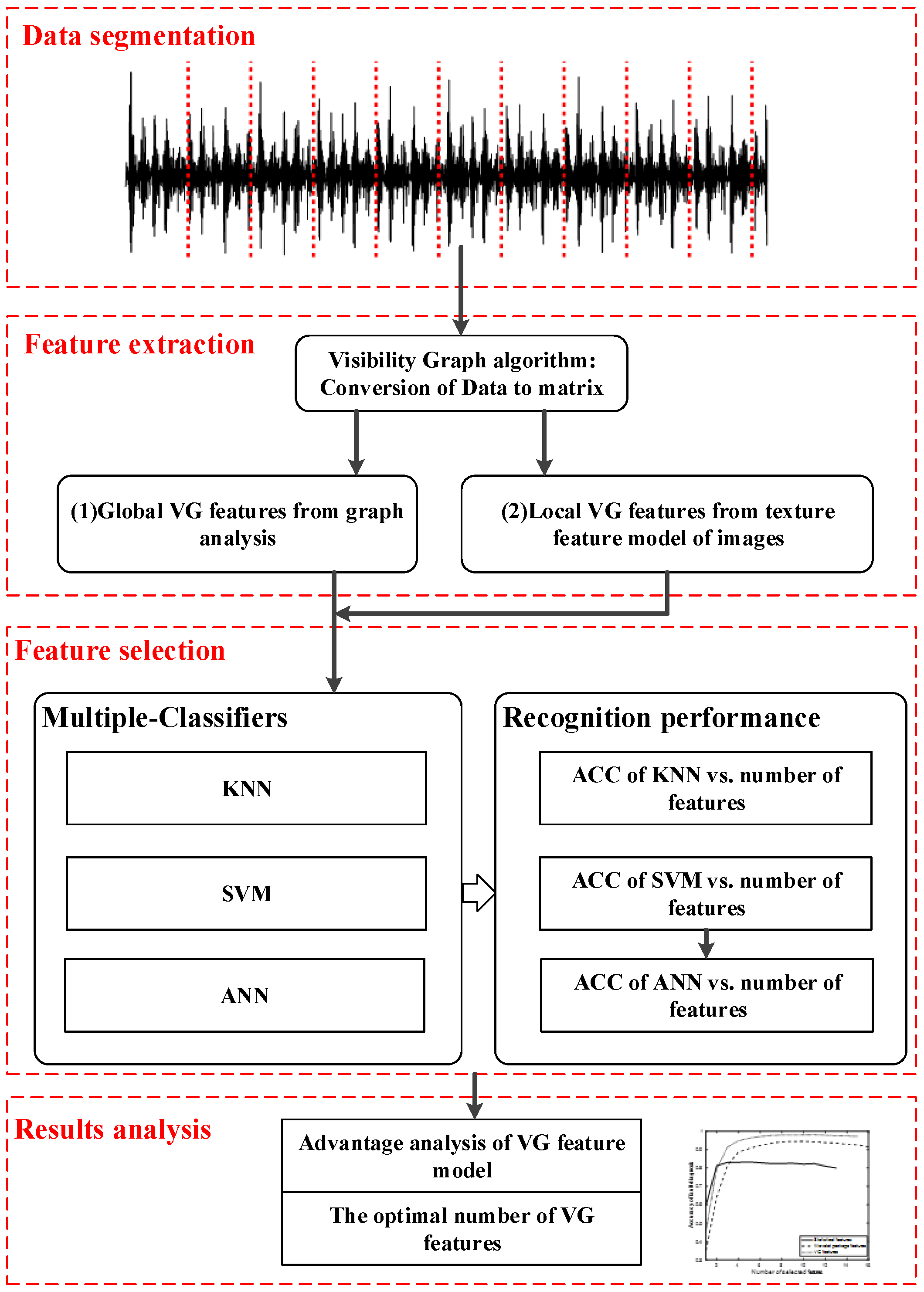
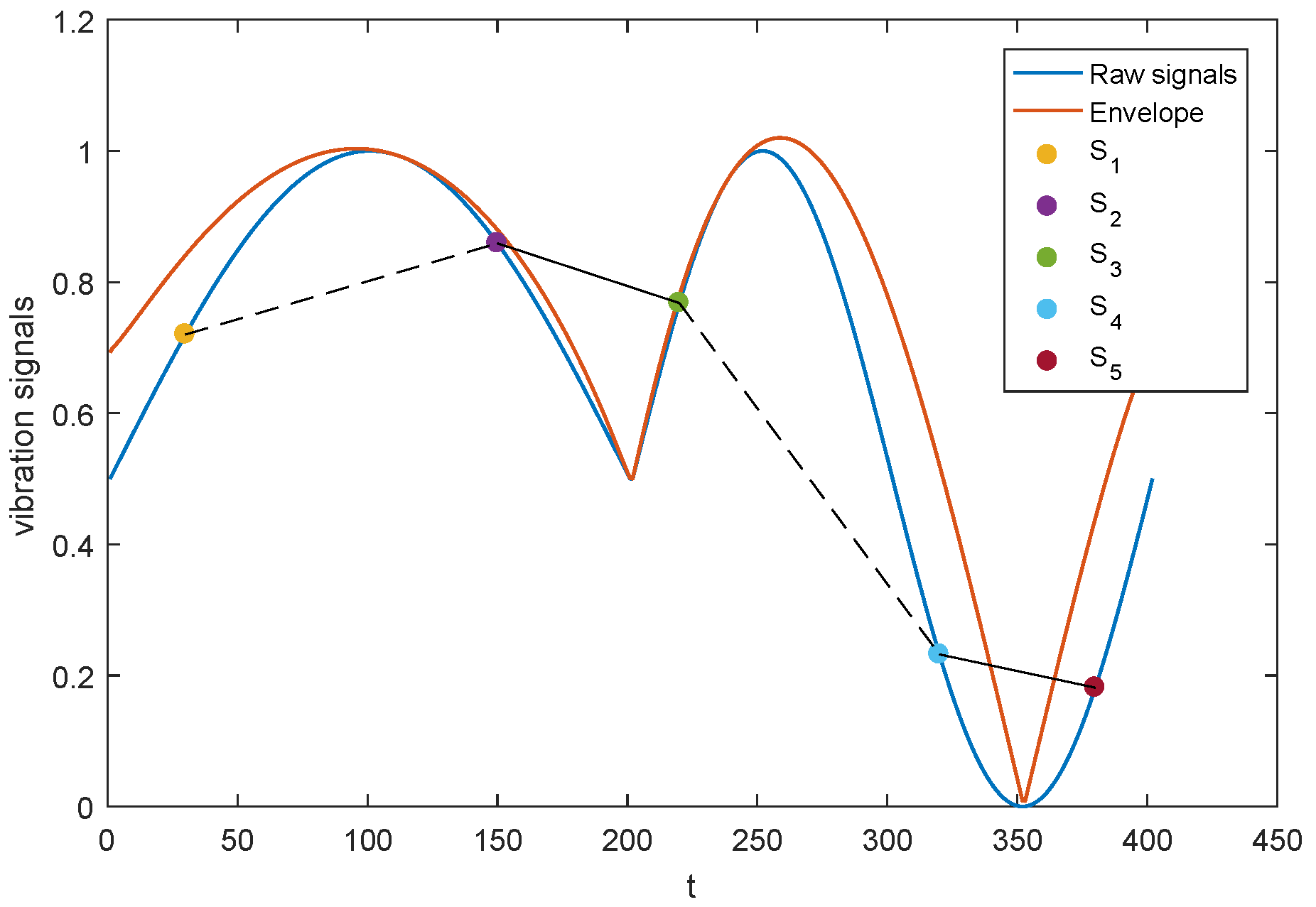

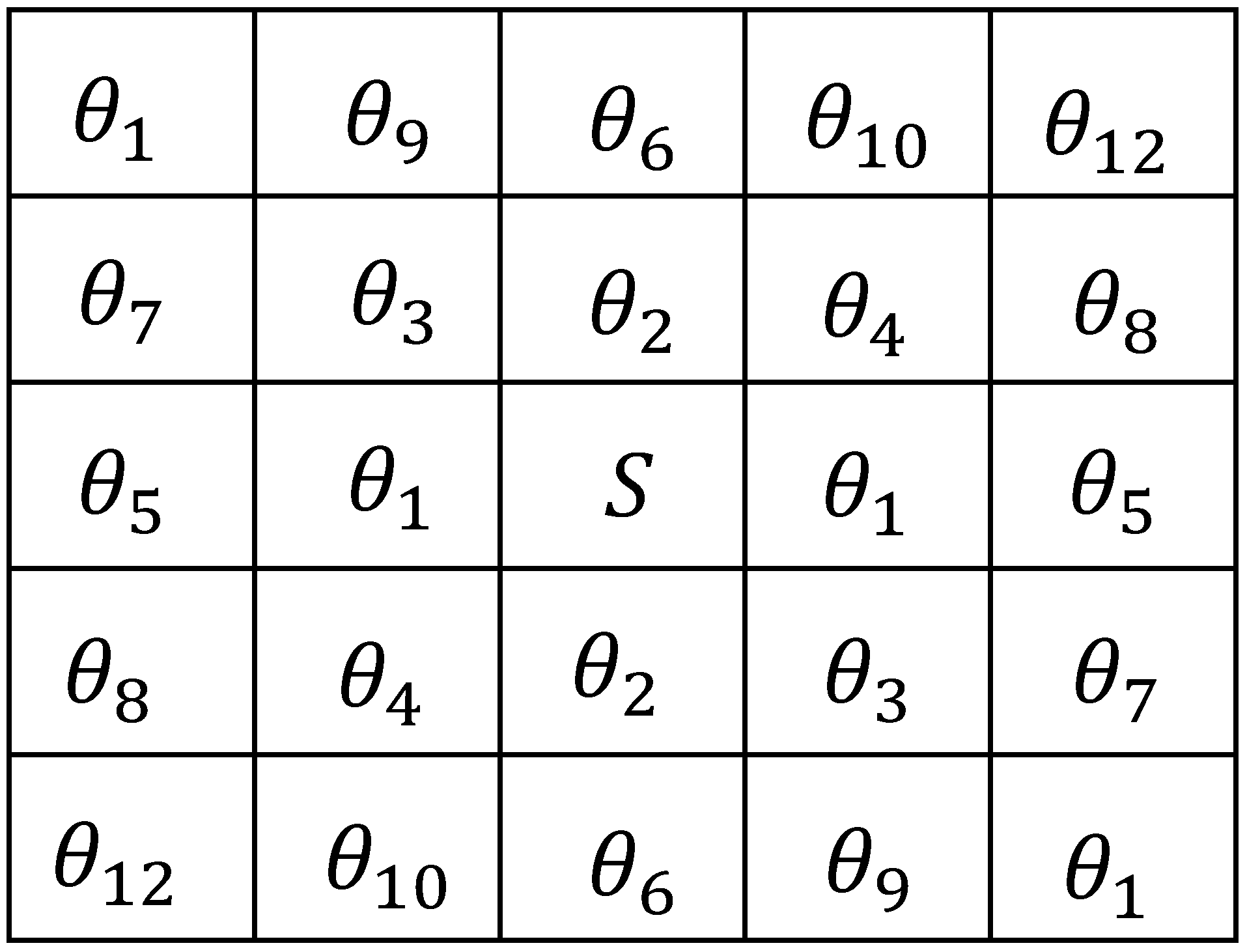

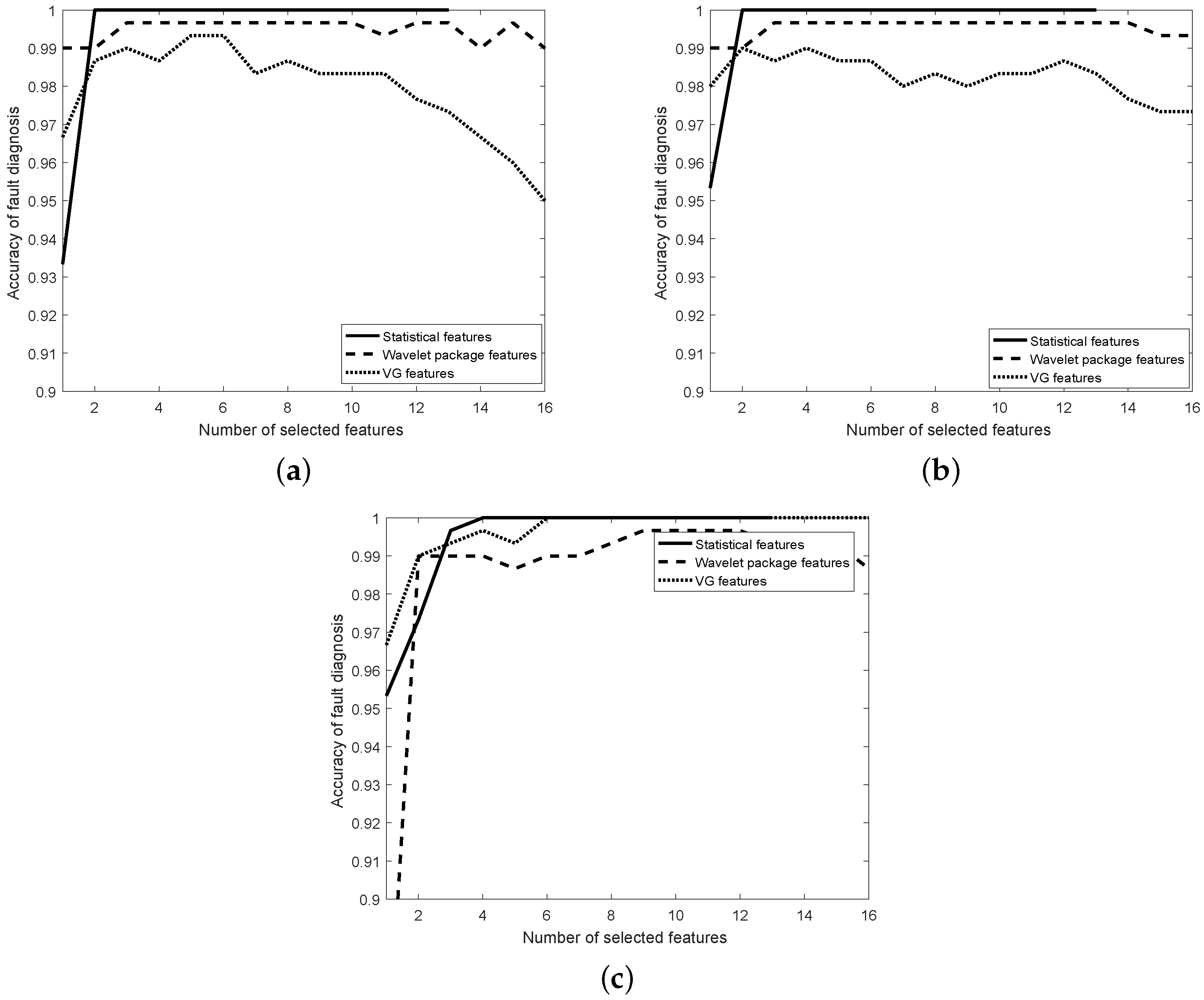
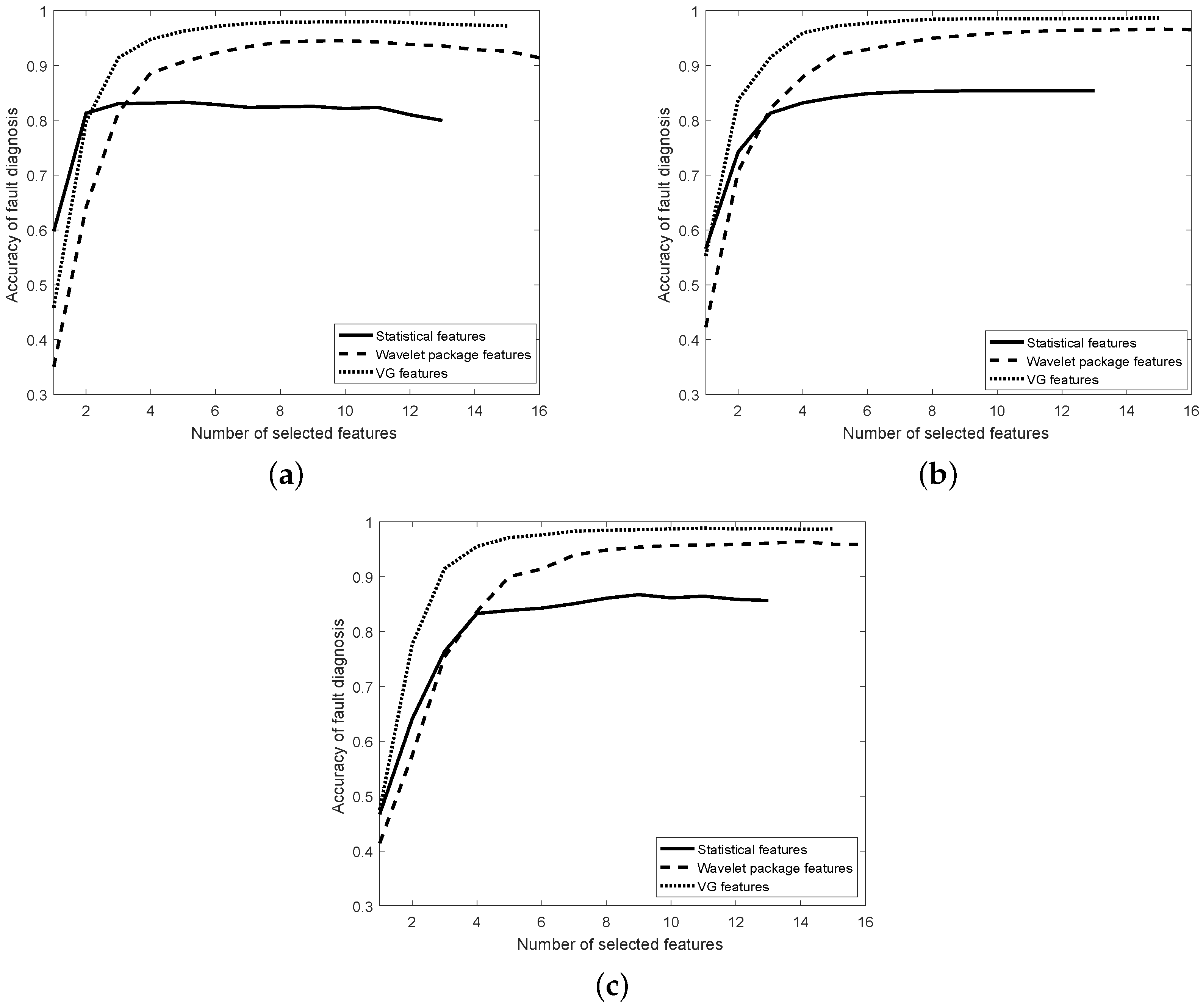
| Class | Name | Samples | Distribution | Data Description |
|---|---|---|---|---|
| 1 | NM | 100 | 33.33% | normal bearings |
| 2 | OR | 100 | 33.33% | Outer race fault |
| 3 | IR | 100 | 33.33% | Inner race fault |
| Class | Name | Samples | Distribution | Data Description |
|---|---|---|---|---|
| 1 | NM_0 | 100 | 2.083% | NM load = 0 |
| 2 | NM_1 | 100 | 2.083% | NM load = 1 |
| 3 | NM_2 | 100 | 2.083% | NM load = 2 |
| 4 | NM_3 | 100 | 2.083% | NM load = 3 |
| 5 | IR007 | 400 | 8.333% | IR fault level = 0.007 |
| 6 | IR014_0 | 100 | 2.083% | IR fault level = 0.014 load = 0 |
| 7 | IR014_1 | 100 | 2.083% | IR fault level = 0.014 load = 1 |
| 8 | IR014_2 | 100 | 2.083% | IR fault level = 0.014 load = 2 |
| 9 | IR014_3 | 100 | 2.083% | IR fault level = 0.014 load = 3 |
| 10 | IR021 | 400 | 8.333% | IR fault level = 0.021 |
| 11 | OR007 | 400 | 8.333% | OR fault level = 0.007 |
| 12 | OR014 | 400 | 8.333% | OR fault level = 0.014 |
| 13 | OR021 | 400 | 8.333% | OR fault level = 0.021 |
| 14 | RB007 | 400 | 8.333% | RB fault level = 0.007 |
| 15 | RB014 | 400 | 8.333% | RB fault level = 0.014 |
| 16 | RB021_0 | 100 | 2.083% | RB fault level = 0.021 load = 0 |
| 17 | RB021_1 | 100 | 2.083% | RB fault level = 0.021 load = 1 |
| 18 | RB021_2 | 100 | 2.083% | RB fault level = 0.021 load = 2 |
| 19 | RB021_3 | 100 | 2.083% | RB fault level = 0.021 load = 3 |
| 20 | IR028 | 400 | 8.333% | IR fault level = 0.028 |
| 21 | RB028 | 400 | 8.333% | RB fault level = 0.028 |
© 2018 by the authors. Licensee MDPI, Basel, Switzerland. This article is an open access article distributed under the terms and conditions of the Creative Commons Attribution (CC BY) license (http://creativecommons.org/licenses/by/4.0/).
Share and Cite
Zhang, Z.; Qin, Y.; Jia, L.; Chen, X. Visibility Graph Feature Model of Vibration Signals: A Novel Bearing Fault Diagnosis Approach. Materials 2018, 11, 2262. https://doi.org/10.3390/ma11112262
Zhang Z, Qin Y, Jia L, Chen X. Visibility Graph Feature Model of Vibration Signals: A Novel Bearing Fault Diagnosis Approach. Materials. 2018; 11(11):2262. https://doi.org/10.3390/ma11112262
Chicago/Turabian StyleZhang, Zhe, Yong Qin, Limin Jia, and Xin’an Chen. 2018. "Visibility Graph Feature Model of Vibration Signals: A Novel Bearing Fault Diagnosis Approach" Materials 11, no. 11: 2262. https://doi.org/10.3390/ma11112262




